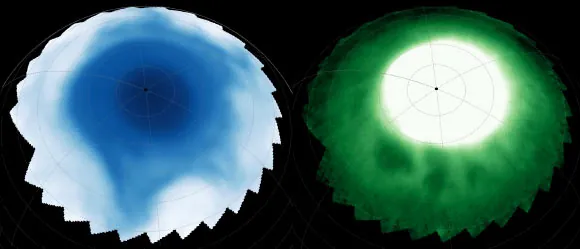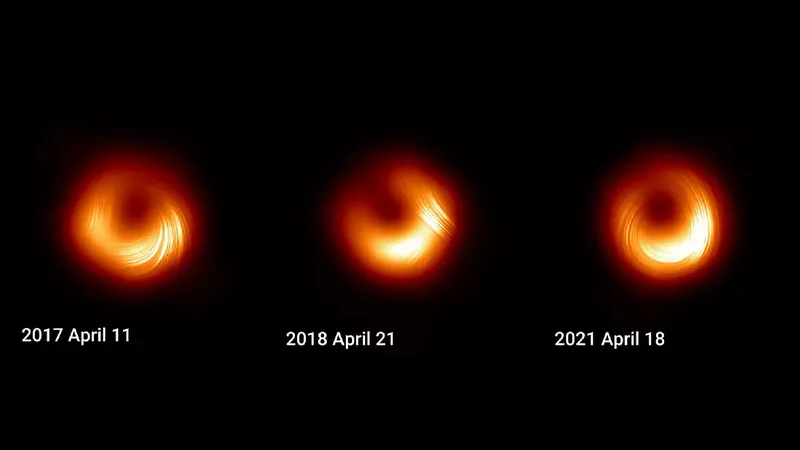
Unveiling Saturn's Mysteries: Webb Telescope Captures Astonishing Details of Its Upper Atmosphere
2025-09-19
Author: Arjun
Astronomers Make Unexpected Discoveries on Saturn
In a groundbreaking revelation, astronomers utilizing the NASA/ESA James Webb Space Telescope have stumbled upon intricate, dark bead-like and asymmetrical star-shaped features within Saturn's ionosphere and stratosphere. These astonishing observations have sent ripples of excitement through the scientific community.
A Surprising Opportunity for Discovery
"This was the first time we could conduct detailed near-infrared observations of Saturn's aurora and upper atmosphere, and the findings completely took us by surprise," shared Professor Tom Stallard from Northumbria University. Instead of the anticipated broad emissions, researchers uncovered intricate patterns, raising questions about their interconnectedness and potential links to the enigmatic hexagon formation found deeper within Saturn's clouds.
The Key Role of H3+ in Understanding Saturn's Atmosphere
The focus of the researchers was the infrared emissions of positively charged molecular hydrogen (H3+), a crucial player in atmospheric reactions that offers valuable insights into Saturn's chemical and physical processes. Webb’s Near Infrared Spectrograph allowed scientists to simultaneously observe H3+ ions high in the ionosphere and methane molecules in the lower stratosphere.
Stunning Structures Reveal Atmospheric Dynamics
In the ionosphere, a series of dark bead-like features were detected nestled within bright auroral halos, stable over hours yet slowly drifting over longer timescales. Meanwhile, in the stratosphere, an asymmetrical star-shaped formation was found extending from Saturn's north pole towards the equator, with a bizarre four-arm pattern that only showcases four of its six expected arms.
A New Era of Atmospheric Research on Gas Giants
"Studying Saturn's upper atmosphere has historically been challenging due to its faint emissions," explained Professor Stallard. "Webb’s extraordinary sensitivity has transformed our observations, revealing unprecedented structures unlike anything seen on other planets." As researchers mapped these features, they intriguingly aligned with the same region of Saturn across different altitudes, hinting at deeper atmospheric processes at play.
Connections Between Magnetosphere and Atmospheric Patterns?
Professor Stallard suggested that the dark beads may result from complex interactions between Saturn's magnetosphere and its swirling atmosphere, potentially offering new insights into the energy exchanges that power Saturn's auroras. Moreover, the appearance of the asymmetric star pattern may point to unknown atmospheric processes linked to the storm’s iconic hexagonal shape.
Future Observations Could Shed Light on Seasonal Changes
Although the discoveries thus far are tantalizing, more observations are necessary to determine their underlying causes. The researchers are eager for additional time to explore these phenomena as Saturn approaches its equinox, a significant event that occurs roughly every 15 Earth years, anticipating dramatic changes in atmospheric features.
A Call for Continued Observation
"As neither atmospheric layer can be effectively observed from the ground, timely follow-up observations with Webb during this pivotal seasonal transition on Saturn are crucial," emphasized Professor Stallard. The findings were recently presented at the EPSC-DPS2025 Joint Meeting in Helsinki, Finland, marking a significant step forward in our understanding of gas giants.




 Brasil (PT)
Brasil (PT)
 Canada (EN)
Canada (EN)
 Chile (ES)
Chile (ES)
 Česko (CS)
Česko (CS)
 대한민국 (KO)
대한민국 (KO)
 España (ES)
España (ES)
 France (FR)
France (FR)
 Hong Kong (EN)
Hong Kong (EN)
 Italia (IT)
Italia (IT)
 日本 (JA)
日本 (JA)
 Magyarország (HU)
Magyarország (HU)
 Norge (NO)
Norge (NO)
 Polska (PL)
Polska (PL)
 Schweiz (DE)
Schweiz (DE)
 Singapore (EN)
Singapore (EN)
 Sverige (SV)
Sverige (SV)
 Suomi (FI)
Suomi (FI)
 Türkiye (TR)
Türkiye (TR)
 الإمارات العربية المتحدة (AR)
الإمارات العربية المتحدة (AR)